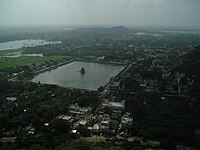https://en.wikipedia.org/wiki/Vedagiriswarar_temple
Vedagiriswarar temple
From Wikipedia, the free encyclopedia
| Vedagiriswarar temple | |
|---|---|
 | |
Location in Tamil Nadu
| |
| Geography | |
| Coordinates | 12°36′24″N 80°03′45″ECoordinates: 12°36′24″N 80°03′45″E |
| Country | India |
| State | Tamil Nadu |
| District | Kanchipuram |
| Location | Tirukalukundram, Tamil Nadu, India |
| Culture | |
| Primary deity | Vedhagireeswarar (Shiva) |
| Consort | Thirupurasundari (Parvathi) |
| Architecture | |
| Architectural styles | Dravidian architecture |
Vedagiriswarar temple is a Hindu temple located in Tirukalukundram (also known as Thirukazhukundram), Tamil Nadu, India.
The Temple[edit]
The town is known for its Hindu temple, Vedagiriswarar temple complex, popularly known as Kazhugu koil (Eagle temple). The consists of two temple structures, one in the foothill and the other atop the hill. The main attraction, the large temple hilltop temple houses the deity of Shiva, known as Vedagiriswarar. The temple at the foothills is dedicated to Parvathi, the consort, known here as Thiripurasundari Amman. The temple at the foothills has four towers (gopurams) closely resembling the architecture of Thiruvannamalai Annamalaiyaar temple
History[edit]
Heads up - The two birds have not been coming to this loction for the last 10 years. The temple agent at the site will not divulge this while selling tickets - and reluctantly admitted to it ONLY after repetitive questions. It is a beautiful place, but it you are going there to see the birds, then be aware that it has not happened in the last 10 years.
The word Thirukazhukundram comes from the Tamil words Thiru (Respectful), Kazhugu (Eagle), Kundram (mount). It was known as "Thirukazhugukundram" in ancient times, which, overtime became Thirukazhukundram. The town is also known as Pakshi Theertham (Bird's Holy Lake) because of a pair of birds -Most likely Egyptian vultures- that are believed to have visited the site for centuries. These birds are traditionally fed by the temple priests and arrive before noon to feed on offerings made from rice, wheat, ghee and sugar. Although punctual, the failure of the birds to turn up was attributed to the presence of "sinners" among the onlookers.[1][2]Legend has it the vultures (or "eagles") represent eight sages who were punished by Shiva with two of them leaving in each of a series of epochs.[3][4] It has also been known as Uruthrakodi, Nandipuri, Indrapuri, Narayanapuri, Brahmapuri, Dinakarapuri, Muniganapuri in the past.
In Mythology[edit]
Sage Bharadwaja prayed to Shiva for a long life so he could learn all the Vedas. Shiva appeared before him and granted him the wish to learn the Vedas and created three mountains each signifying a Veda (Rig, Yajur and Sama).Shiva took a handful of mud and said "Dear Bharadwaja! The Vedas that you could learn are only this handful compared to the mountains present here, even if you live much longer and hence, learning is never ending and could possibly cannot be the route for Salvation". Shiva also said that in Kaliyuga, the simplest and the surest way to salvation is Bhakti or unfettered devotion, service and love of God and his creations. It is believed that the hill on which the Vedagiriswarar temple is built is the mythical mountains signifying Vedas created by Shiva himself. The name Vedagiriswarar means "the Lord of the Vedic Mountains" in Sanskrit.
Poets[edit]
The four Nayanmars, Appar, Sundarar, Manickavasagar and Thirugnanasamandhar visited the temple complex and composed hymns in praise of Vedagiriswarar. A shrine, Nalvar Koil, is dedicated to them. Arunagirinathar composed many of his hymns of Thirupugazh in Thirukazhukundram.
Location[edit]
Thirukazhukundram is located on State Highway 58, 70 km away from Chennai and 15 km away from the famous tourist town Mahabalipuram. It is also 15 km away from Chengalpattu. Near road links are, 10 km away from Old Mahabalipuram Road, 10 km away from East Coast Road and 15 km away from GST road.










No comments:
Post a Comment